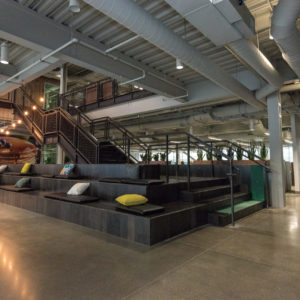The Case for Sustainable Construction Practices
 As the sustainability movement continues to grow, focus in our industry has turned towards sustainable construction practices. The evolution of techniques, certifications, and products has greatly influenced the way contractors and clients view their builds. From sourcing sustainable materials to LEED certification, Oswald has been continuously expanding our sustainable practices.
As the sustainability movement continues to grow, focus in our industry has turned towards sustainable construction practices. The evolution of techniques, certifications, and products has greatly influenced the way contractors and clients view their builds. From sourcing sustainable materials to LEED certification, Oswald has been continuously expanding our sustainable practices.
The construction industry can make a significant impact in the sustainability movement by limiting the amount of materials and energy needed to complete projects. The waste generated by projects can be greatly decreased as well. Learn more about sustainable construction practices – and why they work – below.
Sustainable Construction Practices
1. Construction Waste Management
By reducing waste, the impact on the environment lessens significantly. This includes a greater emphasis on recycling, as well as properly disposing of waste that cannot be reused down the line.
2. Material Selection
Many manufacturers are beginning to make products out of recycled materials. Therefore, architects are choosing those over non-recycled elements. The materials can be anything from bamboo floors to materials sourced from sustainable vendors.
3. Reduced Water Runoff
Many city officials don’t want construction site runoff in their storm sewer systems. This has the potential to back up the sewer system and create a problem. There are several green solutions to this problem, such as containing runoff with silt fencing. A Stormwater Pollution Prevention Plan (SWPPP), for example, is a site-specific document signed by a company executive that identifies the construction practices that could cause excess water pollution and details how they will mitigate the issue.
4. Just-In-Time Protocols
JIT protocols involve delivering the exact amount of materials needed to a jobsite on or around the day they are required. Instead of ordering large quantities of stock, contractors only order exactly what they need. This results in less waste due to overproduction.
Why Sustainability Works
1. Sustainable Construction is Cost Effective
While this may surprise some, going green saves a lot of money in the long run. The upfront investment results in life cycle savings that add up significantly over time. These savings come primarily from reduced utility costs (i.e., lower electricity and water bills).
2. Attract More Tenants/Buyers
Using sustainable construction practices also helps to attract more tenants and buyers. Green buildings are quicker to lease up and sell, and also command higher rent premiums. They also tend to be more attractive to your customer base, leading to more sales.
3. Increased Productivity
Better workspaces result in the reduction of absenteeism. It has been reported that more windows for more light, open-concept spaces, and other “green” construction practices directly result in the increase of productivity.
LEED Certification
One of the most well-known terms in sustainable construction is LEED. LEED Certified buildings are verified to have energy savings, water efficiency, low CO2 emission, and stewardship of natural resources. Oswald’s LEED Accredited Professionals (APs) work with owners to implement green features into their buildings. If the owner wants their building to be LEED Certified, Oswald will facilitate the LEED Certification process.

Empower is LEED Silver

The Urology Group Norwood is LEED certified

Provident is currently pursuing LEED certification
If you’re interested in learning more about LEED, sustainability, or other Oswald practices, be sure to check out our construction page for details.
